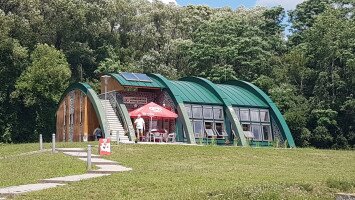
A Mátra aljában, a Zagyva folyó széles völgyére néző lankáson, közvetlenül a 21-es út mellett Tar község határában egy festői szépségű helyen találjuk a Kőrösi Csoma Sándor Emlékparkot és az itt emelt Békesztupát.
Kialakítása, jellemzők
A sztupa a buddhizmus fontos szimbóluma, a megvilágosodást szimbolizáló kúpszerű szakrális építmény és szent hely. Ázsia buddhista országaiban nagyon sok van belőle, de Magyarországon sem ez az egyetlen. Megalkotásának módját maga Buddha határozta meg mintegy 2500 évvel ezelőtt. A sztupa a világban működő külső és belső romboló erők ellensúlyozására épült. Külső, lépcsős formája a spirituális fejlődés, a megvilágosodás felé vezető fokozatos utat jeleníti meg. Belsejében megvilágosult lényektől származó szent relikviák, szimbólumok és írások találhatók.
A tari sztupa a boldogság és jólét teremtésére, megszilárdítására épült, Őszentsége a XIV. Dalai Láma szentelte fel 1992. július 22-én, a magyarországi egyházak és a Magyar Köztársaság meghívott képviselői jelenlétében. A magyar bodhiszattva (buddhista szent), Kőrösi Csoma Sándor halálának 150. évfordulója alkalmából készült. A szentélyt a Tiszteletreméltó Dordzse Lopön Láma Ngawang inspirációjával és szellemi vezetésével négy hónap alatt építették fel különböző egyházak, a Magyar Köztársaság, magánszemélyek és vállalatok nagylelkű adományaiból, sok lelkes, békeszerető ember önzetlen segítségével, tekintet nélkül faji, vallási és szemléletbeli különbségekre.
A sztupa tengelyét képezi az életfa, amelyben szent relikviák kerültek elhelyezésre. A sztupában éjjel-nappal megállás nélkül forog a "mani-korló" (imamalom). Ebben egy tonna papírtekercs van, amelyen Buddha tanának lényegét tartalmazó szent írás áll, amely négyszázmillió mantrát tartalmaz. Amikor Buddha tanított - úgy mondják - megforgatta a tan kerekét, amely ma is forog. Megtekintésekor a sztupát kívülről és belülről is célszerű körbejárni, mégpedig az imahenger forgásával megegyező irányban. Ezalatt ha jókívánságokat, jószándékokat fogalmazunk meg, azok a sztupa áldása révén a mindent átható határtalan jóságtól elválaszthatatlanokká válnak.
A sztupákhoz kapcsolódó hagyományos gyakorlat a felajánlástétel: gyertya, füstölő gyújtása, pénzadomány stb., amelyet személyes vagy általános jellegű jókívánságok kísérhetnek. A területen működik egy igen gazdag árukínálattal rendelkező bolt, az India Shop, ahol a gyakorláshoz szükséges kellékeket (dordzse, csengő, málá, felajánló edények, ereklyetartók, pudzsakönyv-tartó színes brokátból, gyertyatartók, füstölőtartók, hangszerek stb.) kaphatók. Az adományokból és az árusításból származó minden jövedelmet a sztupa, valamit az oktatási és meditációs központ működésének fenntartására és fejlesztésére fordítják.
A sztupát hitre és vallási hovatartozásra való tekintet nélkül mindenki meglátogathatja, betartva azokat az elemi viselkedési szabályokat, amelyeket a megszentelt helyeken egyébként is szokás (pl. cigarettázni nem szabad). A sztupa melletti jellegzetes épületben nyert elhelyezést a Kőrösi Csoma Sándor életútját bemutató állandó kiállítás. Az India Shopban üdítőitalt és kávét is fogyaszthatunk, illetve sok-sok Indiából, Nepálból, Japánból, Kínából, Dél-Amerikából és Dél-Kelet Ázsiából származó ajándéktárgyat is vásárolhatunk. Ha ellátogatunk ide, garantáltan gazdag élményekkel feltöltődve térhetünk haza, s minden bizonnyal vissza fogunk vágyni.
A különböző alkalmi rendezvényeken és közös meditációk megtartására szolgáló hely minden nap ingyenesen megtekinthető.
Hivatalos honlap: www.buddha-tar.hu
















